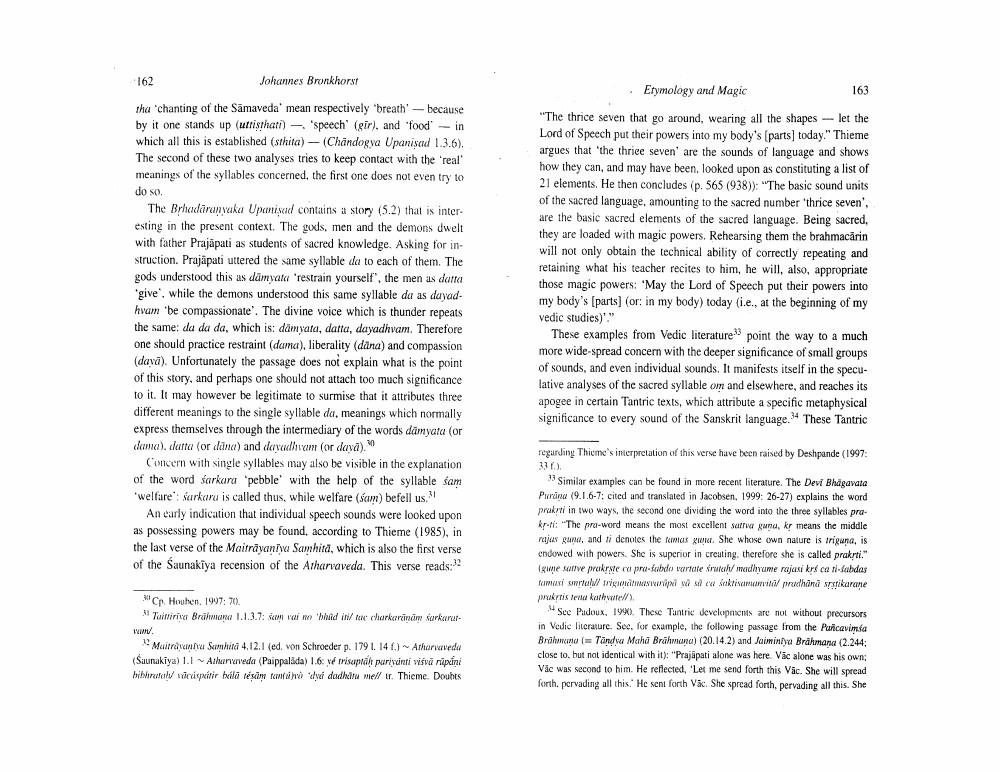Book Title: Etymology And Magic Yaskas Nirukta Flatos Cratylus And Riddle Of Semanticetymologies Author(s): Johannes Bronkhorst Publisher: Johannes Bronkhorst View full book textPage 9
________________ 162 Johannes Bronkhorst tha 'chanting of the Samaveda' mean respectively 'breath' because by it one stands up (uttisthati) 'speech' (gir), and "food" - in which all this is established (sthita)-(Chandogya Upanisad 1.3.6). The second of these two analyses tries to keep contact with the 'real' meanings of the syllables concerned, the first one does not even try to do so. The Brhadaranyaka Upanisad contains a story (5.2) that is interesting in the present context. The gods, men and the demons dwelt with father Prajapati as students of sacred knowledge. Asking for instruction. Prajapati uttered the same syllable da to each of them. The gods understood this as damyata 'restrain yourself", the men as datta 'give', while the demons understood this same syllable da as dayadhvam 'be compassionate'. The divine voice which is thunder repeats the same: da da da, which is: damyata, datta, dayadhvam. Therefore one should practice restraint (dama), liberality (dana) and compassion (daya). Unfortunately the passage does not explain what is the point of this story, and perhaps one should not attach too much significance to it. It may however be legitimate to surmise that it attributes three different meanings to the single syllable da, meanings which normally express themselves through the intermediary of the words damyata (or dama). datta (or dana) and dayadhvam (or dayā).30 Concern with single syllables may also be visible in the explanation of the word sarkara 'pebble' with the help of the syllable sam 'welfare: Sarkara is called thus, while welfare (sam) befell us." An early indication that individual speech sounds were looked upon as possessing powers may be found, according to Thieme (1985), in the last verse of the Maitrāyaṇīya Samhita, which is also the first verse of the Saunakiya recension of the Atharvaveda. This verse reads: 32 Cp. Houben, 1997: 70. 31 Taittiriya Brahmana 1.1.3.7: sam vai no 'bhad in/ tue charkaranam surkarat vam/. Maitrayantva Samhita 4.12.1 (ed. von Schroeder p. 179 1. 14 f.)~ Atharvaveda (Saunakiya) 1.1 Atharvaveda (Paippalada) 1.6: vé trisaptan parivanti viśvā rūpāni bibhrataly/ vācāspátir bálā téṣām tantüvà dá dadharu mel/ tr. Thieme. Doubts Etymology and Magic - let the "The thrice seven that go around, wearing all the shapes Lord of Speech put their powers into my body's [parts] today." Thieme argues that 'the thrice seven' are the sounds of language and shows how they can, and may have been, looked upon as constituting a list of 21 elements. He then concludes (p. 565 (938)): "The basic sound units of the sacred language, amounting to the sacred number 'thrice seven', are the basic sacred elements of the sacred language. Being sacred, they are loaded with magic powers. Rehearsing them the brahmacarin will not only obtain the technical ability of correctly repeating and retaining what his teacher recites to him, he will, also, appropriate those magic powers: 'May the Lord of Speech put their powers into my body's [parts] (or: in my body) today (i.e., at the beginning of my vedic studies)'." 163 These examples from Vedic literature point the way to a much more wide-spread concern with the deeper significance of small groups of sounds, and even individual sounds. It manifests itself in the speculative analyses of the sacred syllable om and elsewhere, and reaches its apogee in certain Tantric texts, which attribute a specific metaphysical significance to every sound of the Sanskrit language.34 These Tantric regarding Thieme's interpretation of this verse have been raised by Deshpande (1997: 33 f.). 33 Similar examples can be found in more recent literature. The Devi Bhagavata Purana (9.1.6-7: cited and translated in Jacobsen, 1999: 26-27) explains the word. prukti in two ways, the second one dividing the word into the three syllables prakr-ti: "The pra-word means the most excellent sattva guna, kṛ means the middle rajus guna, and ti denotes the famas gunnar. She whose own nature is triguna, is endowed with powers. She is superior in creating, therefore she is called prakṛti." (gume suve prakrste ca pra-fabdo vartate śrutah/ madhyame rajasi krs ca ti-fabdas tamasi smrtal/l trigintasvaräpä ya să ca faktisamanvital pradhana sṛṣṭikarane prakrtis tena kathvatel/). 34 See Padoux, 1990. These Tantric developments are not without precursors in Vedic literature. See, for example, the following passage from the Puncavisa Brahmana (Tandya Maha Brahmana) (20.14.2) and Jaiminiya Brahmaṇa (2.244; close to, but not identical with it): "Prajapati alone was here. Vac alone was his own; Vac was second to him. He reflected, 'Let me send forth this Vāc. She will spread forth, pervading all this. He sent forth Vac. She spread forth, pervading all this. ShePage Navigation
1 ... 7 8 9 10 11 12 13 14 15 16 17 18 19 20 21 22 23 24 25 26 27 28 29
